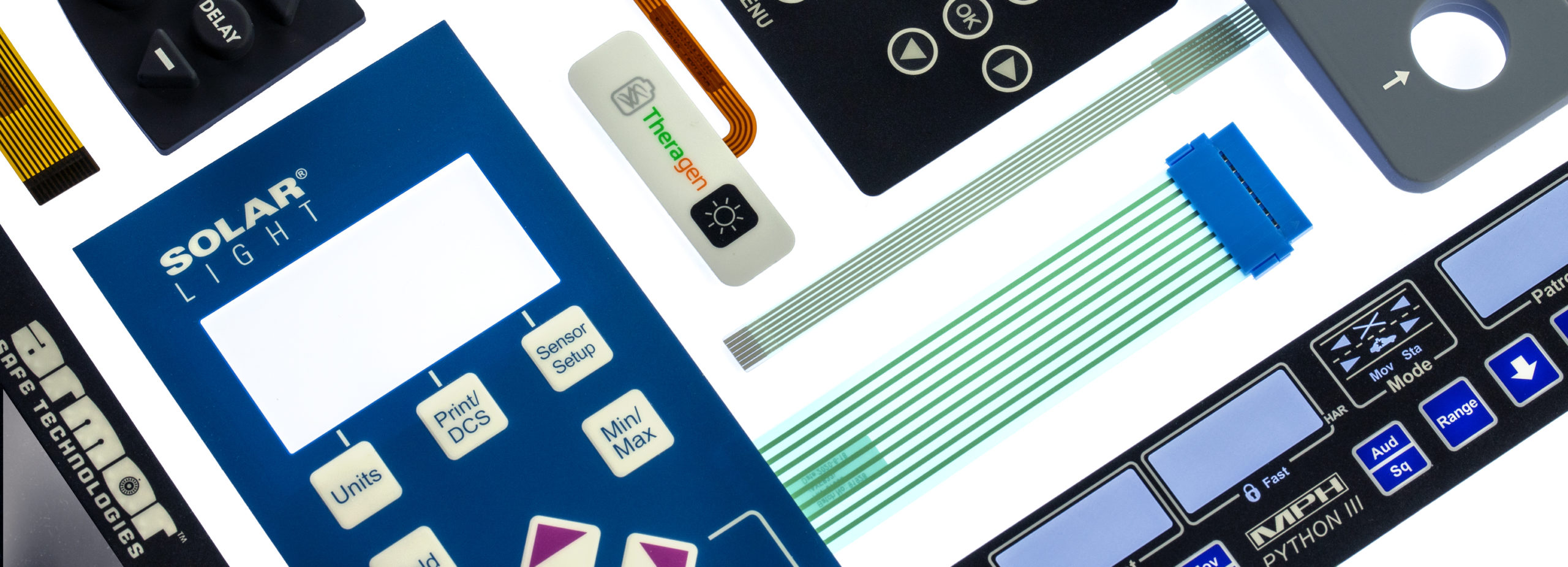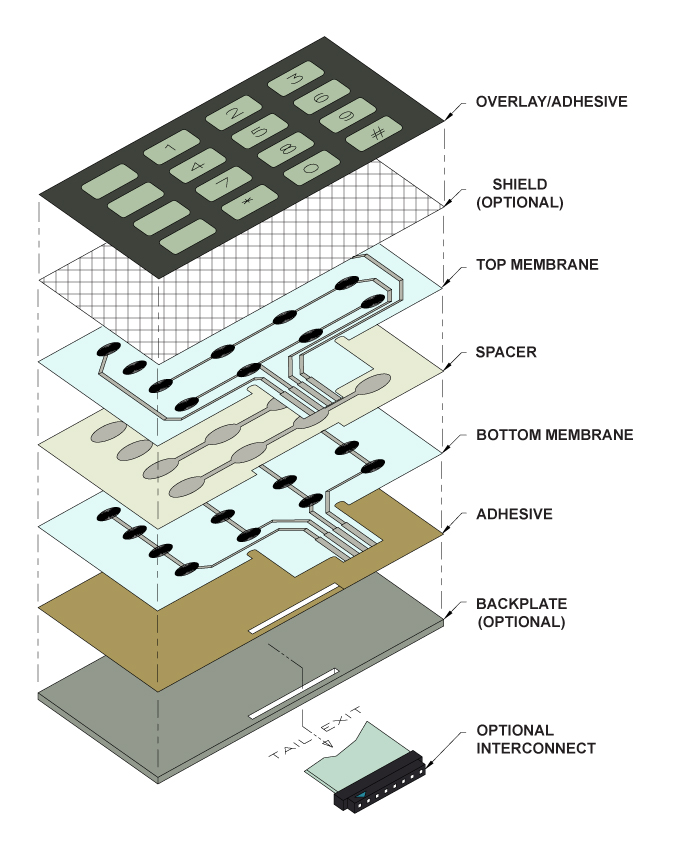Every successful product line begins with selecting the right membrane switch manufacturer early on.
Every successful product line begins with selecting the right membrane switch manufacturer early on.
Blog Article
All Regarding Membrane Change: Comprehending Its Design and Functionality
When you consider the control interfaces in modern-day gadgets, membrane layer buttons commonly enter your mind. These components are greater than just buttons; they blend layout and performance perfectly. Comprehending exactly how they function and what makes them efficient can transform your point of view on daily electronics. However, there are subtleties to their design and efficiency that you might not know. Let's discover what collections membrane switches over in addition to various other control systems.
What Are Membrane Switches?

Their seamless nature makes them very easy to tidy and immune to dust and moisture, an essential feature in lots of atmospheres. Membrane switches can additionally be customized concerning shape, dimension, and graphics, allowing makers to develop one-of-a-kind user interfaces tailored to particular products. Plus, they're lightweight and slim, which assists in decreasing the general mass of gadgets. Generally, membrane layer switches play a substantial duty in boosting individual experience throughout a vast array of applications.
Exactly How Membrane Changes Work
When you press a secret on a membrane layer button, it triggers a simple yet reliable device. membrane switch manufacturer. The top layer, often made of adaptable material, presses down onto a conductive layer beneath it.
You'll see that the responsive responses varies based upon the button layout, supplying either a soft click or a much more pronounced feedback. When you launch the key, the membrane layer returns to its original setting, resuming the circuit and quiting the signal. This process takes place virtually instantaneously, ensuring a receptive user experience.
Membrane layer switches are popular due to their longevity and resistance to dirt and moisture, making them excellent for different applications, from family home appliances to clinical gadgets. Understanding this procedure aids you appreciate their prevalent use.
Secret Components of Membrane Buttons
Recognizing the crucial components of membrane layer switches is essential for understanding their performance and design. The safety layer shields against ecological aspects and put on, expanding the button's life expectancy. By understanding these parts, you'll acquire understanding into just how membrane switches run and their significance in various applications.
Materials Used in Membrane Layer Switch Over Layout
The efficiency and toughness of membrane switches heavily depend on the materials used in their layout. You usually run into polyester and polycarbonate as main substratums because of their outstanding toughness and adaptability. These products withstand scratches and chemicals, making them ideal for requiring atmospheres.
The conductive layers often make use of silver or carbon, selected for their integrity and conductivity. membrane switch manufacturer. Silver supplies exceptional performance, while carbon is a cost-effective option. For the overlay, you might consider a matte or glossy coating, depending on your aesthetic requirements and individual experience
Make certain to pick adhesives that withstand environmental variables like temperature and humidity. Selecting the appropriate materials will ensure your membrane layer button stands the examination of time.
Style Considerations for Membrane Layer Switches
While making membrane layer buttons, it's vital to consider different aspects that affect their performance and customer experience. Begin by concentrating on the format and switch dimension; make certain they're user-friendly and very easy to navigate. Consider the tactile comments you wish to supply-- will users require a visible click or a softer touch? Additionally, consider the here are the findings materials you'll use, as they'll influence longevity and appearances.
Don't overlook the visuals layout; clear labeling and color contrast are considerable for presence. Validate your style fits ecological elements, like wetness or temperature variations, which can influence efficiency. Lastly, keep in mind the importance of screening prototypes with real users to collect feedback and make necessary adjustments. This iterative process aids you improve the style, confirming it fulfills both practical and visual demands effectively. By meticulously considering these aspects, you'll develop a membrane switch that improves functionality and fulfillment.
Applications of Membrane Layer Switches
Membrane switches are versatile elements located in various applications, from commercial equipment to consumer electronics. You'll see their impact in devices that news require resilient interfaces and in tools that take advantage of streamlined styles. Understanding these applications assists you value the capability and practicality of membrane switches in everyday innovation.
Industrial Equipment Usage
When you're looking to improve the functionality of commercial devices, membrane layer buttons offer a dependable service that incorporates toughness with straightforward design. These switches are best for rough atmospheres, supplying resistance to dirt, wetness, and chemicals. Embrace membrane switches to enhance your operations and improve overall efficiency.
Customer Electronic Devices Combination
In the domain of consumer electronics, membrane layer switches play a necessary role in enhancing individual communication and gadget functionality. You'll locate them in devices like microwaves, remotes, and video gaming consoles, pop over to this web-site supplying a smooth means to interact with technology. Their sleek design allows for simple assimilation right into various items, making controls instinctive and user-friendly. With their capacity to integrate graphics and backlighting, you can enjoy a modern-day aesthetic that enhances the device's overall appearance. Membrane switches likewise ensure durability and resistance to dust and dampness, expanding the life expectancy of your electronic devices. By picking membrane switches, you boost not just the performance yet additionally the style of your gadgets, making everyday communications smooth and satisfying.
Advantages and Downsides of Membrane Buttons
While membrane buttons offer a range of advantages, they likewise come with some disadvantages that you need to think about. One substantial advantage is their compact style, making them optimal for space-constrained applications.

Nevertheless, there are downsides. Membrane layer switches can have a shorter lifespan contrasted to mechanical buttons, especially under hefty use. They can additionally be much less tactile, which may influence individual comments throughout operation. Moreover, if harmed, fixing them can be difficult and usually needs complete substitute. Eventually, their level of sensitivity to severe temperatures and ecological problems might limit their efficiency in particular setups. Balancing these pros and cons will help you figure out if membrane buttons are the best fit for your project.
Regularly Asked Questions
How Much Time Do Membrane Switches Over Normally Last?
Membrane layer changes normally last between 5 to 10 years, depending on use and ecological problems. You'll desire to review factors like wear, exposure to wetness, and temperature level variations to assess their longevity successfully.
Can Membrane Layer Switches Over Be Personalized for Details Designs?
Yes, you can customize membrane buttons to fit details designs (membrane switch manufacturer). You'll have the flexibility to pick shades, shapes, and formats that match your job's demands, guaranteeing they mix effortlessly with your overall visual
What Is the Cost Variety for Membrane Change Manufacturing?
The price range for membrane switch production typically drops between $1 and $10 per device, relying on elements like style intricacy, amount, and materials. You can obtain quotes from makers to discover the ideal choice.

Are Membrane Switches Water Resistant or Resistant?
Membrane layer switches can be made to be water resistant or resistant, relying on materials made use of and building and construction approaches. If you need them for wet environments, ensure you define those requirements during the design procedure.
How Do Membrane Layer Changes Compare to Conventional Switches?
Membrane layer switches are normally thinner and much more adaptable than traditional buttons, offering a sleek layout. They're usually much easier to clean and integrate, however may not provide the responsive comments you're used to with mechanical alternatives.
Final thought

Report this page